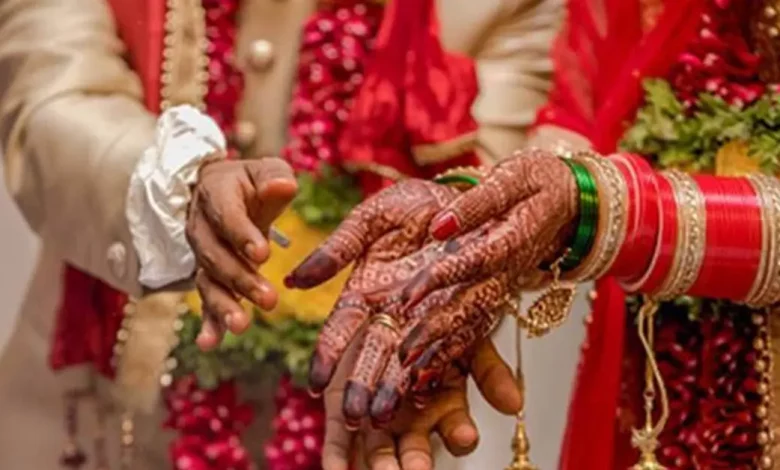
Context- A parliamentary committee examining a Bill seeking to raise the age of marriage of women from the present 18 years to 21 has been given another extension to submit its report.
About
- The Prohibition of Child Marriage (Amendment) Bill, 2021, was introduced within the Lok Sabha in 2021 and was referred to the Standing Committee on Education, Women, Children, Youth and Sports.
The Prohibition of Child Marriage (Amendment) Bill, 2021
- The Bill amends the Prohibition of Child Marriage Act, 2006 to increase the minimum age of marriage of women to 21 years. Further, the Bill will override any other law, custom, or practice.
- Under the 2006 Act, someone married under the minimum age may practice for annulment inside years of attaining majority (i.e., before 20 years of age). The Bill increases this to 5 years (i.e., 23 years of age).
Legal Age of Marriage in India
- According to the National Family Health Survey 2019-21 (NFHS-five), 23% of girls between the age of 20 and 24 had been married earlier than 18 years of age.
- In India, the exercise of infant marriage changed into first legally prohibited through the Child Marriage Restraint Act, 1929.
- According to the 1929 Act, marriage of girls under the age of 14 years and boys below the age of 18 years became prohibited.
- This Act was amended in 1978 to increase the minimum age to 18 years for women, and 21 years for men.
- The Prohibition of Child Marriage Act, 2006 changed the 1929 Act, with the same minimum age limits.
Arguments in Favour of Increasing the Marriageable Age:
- Educational Opportunities: Increasing the marriageable age to 21 in India can make a contribution to better instructional attainment for women.
- Career Development: Raising the marriageable age affords Indian women with the danger to focus on constructing their careers earlier than entering into marital commitments.
- This can lead to increased workforce participation, economic independence, and professional development, contributing to the economic growth of the country.
- Health and Maternal Well-being: Women who marry later are usually greater physically and emotionally prepared for being pregnant and childbirth, contributing to reduced maternal and infant mortality rates.
- Gender Equality: Raising the marriageable age aligns with the principles of gender equality by providing both men and women with similar opportunities for personal and professional growth.
- Empowerment of Women: Delaying marriage empowers girls by allowing them more time to explore their personal aspirations and make knowledgeable choices approximately their lives.
- Reducing Child Marriages: Increasing the marriageable age serves as a legal deterrent to child marriages, protecting young girls from the physical, emotional, and social consequences associated with early unions.
- Social and Emotional Maturity: At the age of 21, people are likely to have a better understanding of themselves, their dreams, and the duties that include marriage.
- Population Control: Delaying marriage can make a contribution to better family planning and population control.
Arguments Against Increasing the Marriageable Age
- Cultural and Traditional Variability: Critics argue that different communities have their own norms and expectancies regarding an appropriate age for marriage. Imposing a uniform age restriction won’t align with the cultural variability across the nation.
- Individual Freedom and Autonomy: Some individuals can be emotionally and mentally prepared for marriage at 18, and imposing a better age restriction may be seen as proscribing their personal picks and decision-making abilities.
- Legal Consistency: Critics may factor out that the legal age for balloting and consenting to sexual activity in India is already 18.
- Setting a unique age for marriage introduces inconsistency within the criminal framework, and combatants argue that individuals have to be taken into consideration mature enough for all criminal obligations at the same age.
- Role of Parents and Family Decision-Making: Increasing the marriageable age undermines the function of parents and families in choice-making.
- Unintended Consequences on Relationships: Delaying marriage should bring about individuals entering into premarital relationships without the legal commitment of marriage.
- This can also lead to a shift in societal norms and values, which some may view as having negative consequences.
- Social Stigma and Marital Status: Imposing a higher marriageable age could result in social stigma for individuals who choose to marry earlier.
- This can also lead to societal judgments and challenges for folks who do no longer comply with the new legal age limit.
- Female Foeticide: The strain to educate young women until 21 among negative households will increase the rate of intercourse-selective abortion in the country.
- Safety Concerns: The fear of rape or elopement can even loom huge, especially in the rural regions because of the proposed law.
Way Ahead
- The result lies in empowering younger girls, encouraging them to get knowledgeable and reap fiscal autonomy schooling for women, and conducting mindfulness programs on the ill goods of nonage marriages.
- Government should subsidized training and healthcare installations for you to insure that girl’s right to live a life of her choice is admired and preserved.
- Governments have to also come with an on- ground medium to spread mindfulness and apply this policy change rigorously for the benefits to reflect in the society.
Source: The Hindu





.png)



